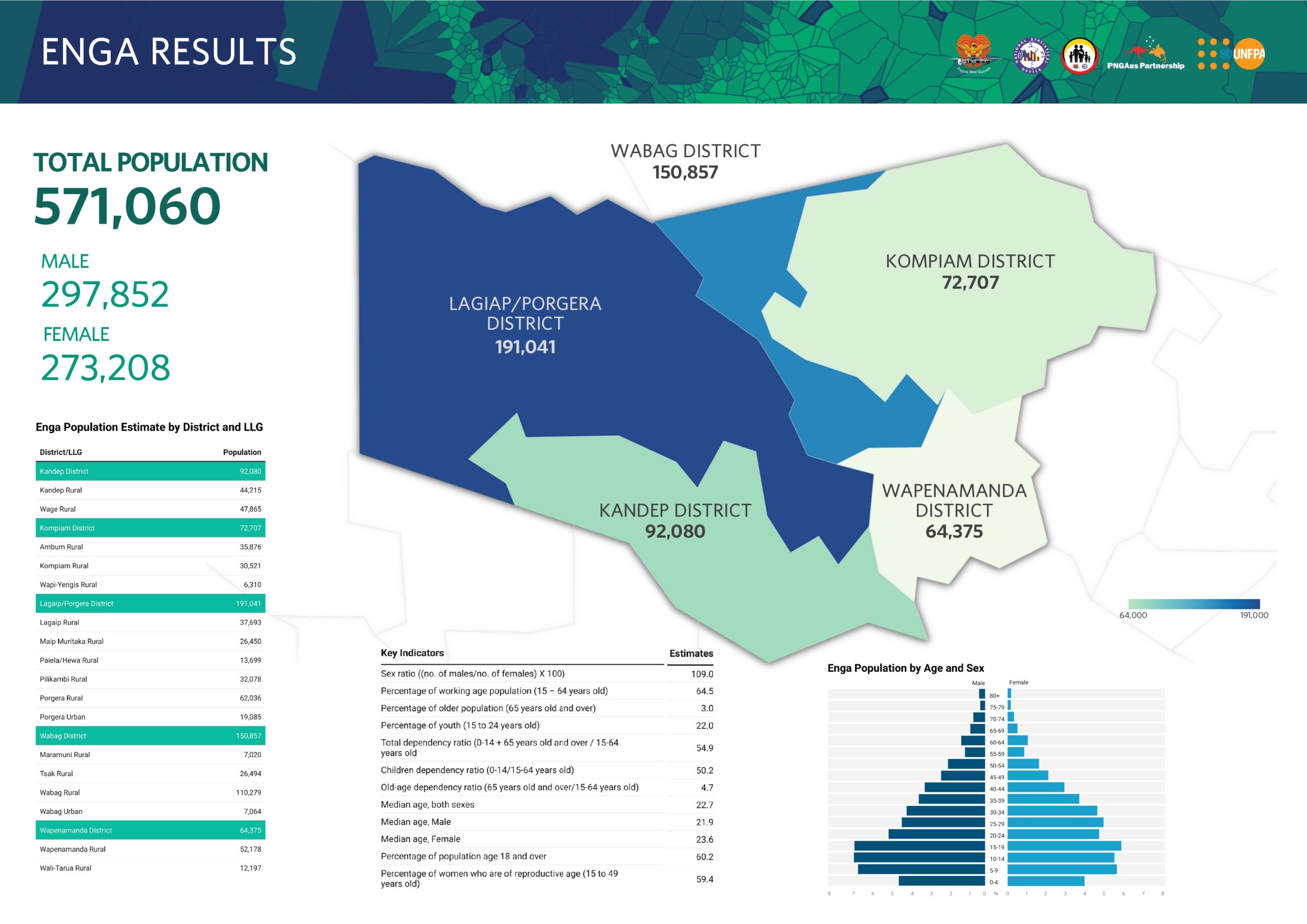Provincial Back Ground

Enga Province
Enga Province, located in Papua New Guinea, spans an area of 11,800 square kilometers and has a population of 571,060 according to the 2021 Census.The province comprises 6 districts, Wapenamanda, Wabag, Kompiam, Porgera, Kandep and Laiagam, with its provincial capital located in Wabag. It is the country’s sixth most populous province and shares boundaries with Western Highlands, Southern Highlands, Hela, West Sepik, and East Sepik provinces.
The province faces challenges such as rugged terrain, weak infrastructure connectivity, high transport costs, governance issues, and deteriorating law and order. These factors hinder its development and pose obstacles to economic growth and the provision of essential services. However, Enga Province benefits from the advantage of a homogeneous population that speaks a single language (“Enga Language”), which facilitates communication and cultural cohesion among its residents.
Efforts to address Enga Province’s challenges require a multi-faceted approach. Improving infrastructure connectivity, including road networks and transportation systems, is crucial to reducing transport costs and improving access to services. Strengthening governance structures and law enforcement is necessary to restore stability and security in the region. Additionally, promoting economic diversification, investing in education and healthcare, and fostering sustainable development are key factors in improving the living standards of the population and driving progress in Enga Province.
Districts and the LLG boundaries
in Enga Province
The Enga provincial population according to the 2021 National Census counts was 571,060 and its population growth rate was 2.9% respectively. Comparatively, the above accounts for 5.7% of the national or 15% of the regional population. Based however on the prevailing growth rate of 2.9%, the above would mean an increase of 3,500 – 4,500 new individuals annually and should this growth trend continues, the total population is projected to reach 600,000 by 2025.
An analysis of key population characteristics for the province reveals of uneven trends in population distribution in the province. For instance, demographic and population studies have confirmed of higher population densities in the Lai, Ambum, Tsak and Lagaip Valleys with 360 persons per square kilometer.
|
Population Distribution Population density by districts as recorded in the 2021 population census.
|
Economy
The Provincial economy is dominated by the currently closed Porgera Gold and Silver mine, the mainstay of EPA revenues since 1990. The closure of the mine, albeit temporarily has had a devastating impact on the 2021 budget and will be felt into 2022. In addition to revenues derived from royalties and other benefit sharing arrangements, Porgera Joint Venture also provides direct employment for around 1,600 Engans and income for hundreds more small and medium enterprises.
“Papua New Guinea’s GDP per capita is USD 2,829. No specific data is available for Enga, but anecdotal field work indicates GDP per capita in Enga is likely to be half the national number USD1415 per annum or USD3.87 per day or PGK4,964 per annum or PGK13.60 per day. There is no employment data for Enga but it assumed that around 90+% of people are engaged in subsistence farming”.
Enga has long recognised the need to diversify the economy and the current situation presents a good opportunity to make significant roads.
Enga is also the home to one of the world’s most productive gold and silver mines, Porgera, located at an altitude of some 2,500 meters at the head of the Porgera Valley. Opened in 1989, Porgera produces around 550,000 ounces of gold and 90,000 ounces of silver annually, provides jobs to around 3,300 people and contributes around 10% to PNG’s total annual exports.
Enga Province is a small equity participant in the mine via Mineral Resources Enga (MRE) Limited, a consortium between Enga Provincial Government and Porgera Landowners, each owning 2.5% of Porgera. Royalties and dividends from the mine are an important contribution to the annual Enga budget but are a fraction of the taxes and other income flowing from the mine to the National Government.
In 2020 the mine closed for re-negotiations with the Government of PNG and Enga Provincial Government led by the National Government. The outcome sought was a larger share of equity and income for local landowners, Enga and the State. At the time of writing, the negotiations have concluded but the mine remains closed with an expected opening early to mid 2022.
The mine closure has had a significant impact on Enga Provincial revenues but has forced a thorough examination of how to grow and develop the province without mine incomes and the loss of nearly 1,600 Engans directly employed by the mine and the hundreds of small and large businesses engaged as contractors to the mine.
Enga is highly productive with rich alluvial soils suitable for agriculture though this is constrained by steep gorges and mountainous terrain, especially in the middle and upper Districts. Farming remains largely informal and subsistence with produce more than the farming family’s needs sold to nearby markets such as Mount Hagen.
In recent times, new agribusiness models have been introduced by EPG partner Innovative Agriculture who have developed strawberry farms at Sirunki. Agriculture is largely hampered by lack of access to larger formal markets and electricity; tribal fighting; commercial-scale farming land and high transport costs.
Development in Enga for the past two decades has focused on improving access to education and health care. These strategies have raised expectations and the profile of Enga but more needs to be done to convert these strategies to improved livelihoods. Enga Province has invested heavily through the dedicated Enga Children’s Fund and now needs to pivot to diversify the development approach to ensure both sustainable social and economic outcomes drive investment and create employment and Provincial revenues to facilitate financial self-reliance at both the individual and Provincial level.
The establishment of the Innovative Enga University as an umbrella institution to provide high quality, tertiary education to all Papua New Guineans and Pacific Neighbours in Enga is a step in the right direction to consolidating education efforts.
Service delivery to citizens is improving but is predominantly lagging the rest of the World. Minimum services such as electricity, water, waste removal, health care and education need substantial improvements in access and quality.
The pace of progress is slower than the population growth rate and people’s expectations where in a digital age, Engans can see through their devices the quality of life elsewhere.
Engan way of life remains tied to tribal alliances and traditions despite the large influence of Christianity. Tribal fighting is common and creates substantial disruption to everyday lives and is a major detractor to visitors and business investment, not to mention the impact on Engan people.
New trends, not associated with traditional disputes, such as violent crimes against women; child abuse and prostitution, have risen as has sorcery related crimes. Unless a safe and peaceful community in Enga becomes the norm, a substantially improved way of life and financial self-sustainability in Enga remains out of the realms of possibility. The National Government in close partnership with EPG and EPA, deploys the PNG Defense Force to Enga all year round at substantial cost to encourage peace.
Police numbers, including the last resort in riot and crime control, the Mobile Squad, continue to rise in Enga. The Village Court system survives but has been unintentionally disempowered by both Police and PNGDF. Learning from the past and reverting to a traditional model, with Village Court Magistrates re-empowered as the authority of the community, if coupled with Police cooperation, will ensure the Village Court is a legitimate means to settle issues and rulings are enforced.



